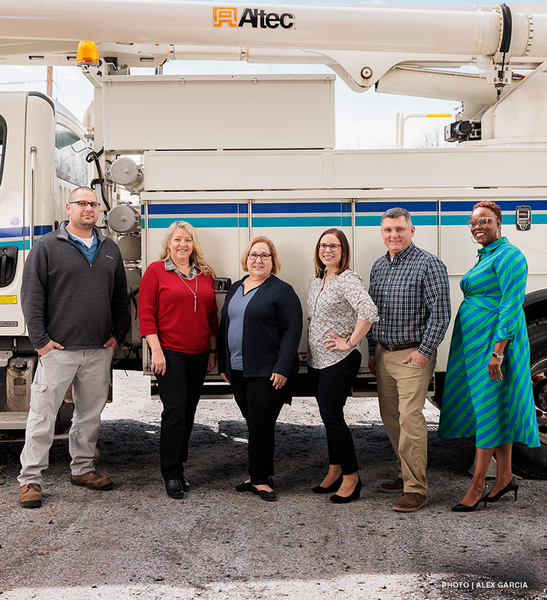TD Magazine Article
Energizing Employees
PPL Electric ups the wattage on its training and development programs.
Thu Jun 15 2023

PPL Electric Utilities: 2023 BEST Award Winner, #14

PPL Electric ups the wattage on its training and development programs.
It's no surprise that the talent development team at PPL Electric Utilities strives to "power up" the potential in its more than 2,300-employee workforce. The utility delivers electricity to more than 1.4 million homes and businesses in central and eastern Pennsylvania, with one of the most advanced grids in the US. It regularly ranks among the country's best utility companies for reliability and customer satisfaction. Employees come from diverse backgrounds, with varying levels of formal education. TD develops programs that prime workers for the next steps in their careers, enabling the utility to fill job openings both from within and externally.
"Our robust training and apprenticeship programs prepare employees with the skills needed to deliver the electricity our customers rely on to power their lives each day," explains Patti Scaramuzzo, director of training, content, and integration. "Our craft programs prepare employees for high-demand, highly compensated careers."
Homegrown training
For many positions at PPL Electric, such as customer service assistants, relay test technicians, and system operators, no formal learning programs exist in colleges or technical schools. "There are no degrees for some of the specific skills our employees need, such as managing and controlling power on the electric grid," says Scaramuzzo. While a few post-high school trade schools offer training for utility positions, "we also hire candidates that haven't been through those programs. Additionally, there is a critical need for employees to learn on our systems and use our procedures to ensure they do their jobs safely and properly."
Because TD is fully responsible for training, team members conduct a thorough task and skills analysis of the craft position during an apprentice program's initial development. "When we find gaps in performance, we revisit an analysis, pinpoint skills gaps, and then develop an approach to fill those gaps," states Scaramuzzo. "That approach must be applied to those currently in the position and to the apprentice training program for that position."
The approach proved instrumental in adapting instruction in electrical theory after identifying a skills gap in the area. The company previously taught electrical theory using a more conventional learning model—starting with the basics and theory, and then progressing into equipment, Scaramuzzo notes. "We found that employees struggled to connect theory to either the procedures used to install equipment or the safety rules that are used to guide our work."
The new behavioral approach begins with a fictionalized real-life scenario and discovery-learning exercise that asks, "How did this happen?" Scaramuzzo explains that now, "once the students discover why a particular incident happened, we discuss different electrical theories that explain what occurred and connect the theory to procedures and safety rules."
She adds: "The initial conclusion was provided by the student, so the theory is absorbed better." The training team follows up with additional fictionalized scenarios and asks students to apply the theory together. "This technique reinforces the connection between theory and real-life scenarios that promote critical thought." After the company adopted the model, students and their supervisors provided overwhelmingly positive feedback.
Safety first
The training programs feature a safety-focused, constructive approach that encourages participants to speak up if they see something unsafe.
"We must emphasize the dangers that exist if anyone lacks the necessary skills, forgets what they've been taught, does not follow procedures and safety guidance, and fails to use human performance tools, which are in place to help people avoid mistakes and injuries," explains Scaramuzzo. Employees also must adhere to regulatory requirements to ensure a safe and reliable grid.
PPL Electric finds that its safety-focused training programs are working: In a recent success story, a field manager reported that his trainees provide the majority of "good catches"—in other words, recognizing a potentially hazardous situation, then preventing an incident due to corrective action or a timely solution. "Our learners are taught that speaking up is critical and that we must learn from our mistakes and do better," Scaramuzzo states.
The company emphasizes safety all the way up the ranks and recently instituted regular First Report of Incident meetings coupled with safety leadership training. This approach led to a 47 percent reduction in injuries. PPL Electric implemented the program "to ensure that people leaders effectively and thoroughly communicate the details about incidents so their employees are aware. We also want them to share the actions taken to prevent them from occurring again," says Scaramuzzo. "Our goal is to teach frontline supervisors to become exceptional leaders in promoting our safety culture.
"First Report of Incident meetings represent a real-world, large-scale application of learning from failure," she adds. "It fosters people leaders to share incidents with their employees and cultivates conversations about the incidents." The results speak for themselves: The company achieved its safest year on record in 2022. Plus, Scaramuzzo reports, "the safety incidents that occurred were less serious and resulted in fewer average days away from work than in years past."
Boosting customer satisfaction
PPL Electric recently added more self-service options and improved call routing for customers. While doing that, it enhanced customer service representative training to better meet customers' needs. CSRs participate in self-paced training courses, watch microlearning videos, and study day-one guides.
"This allows us to train CSRs in these new capabilities with less time away from the phones. Our representatives see what the customer sees when signed into their online profile," explains Scaramuzzo. "The microlearning videos show processes, such as how a customer can start or stop service and enroll themselves on automatic bill payments, increasing representative confidence when assisting with less frequent processes and improving customers' experience."
From CSRs and line workers to supervisors and managers, PPL Electric's TD team prepares all employees for a brighter future via personalized training and a safety-first culture.
View the entire list of 2023 BEST Award winners.

